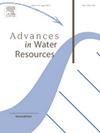Effects of tides and subsurface dams on the land-sourced contaminant transport: Laboratory and numerical investigation
IF 4.2
2区 环境科学与生态学
Q1 WATER RESOURCES
引用次数: 0
Abstract
The presence of tides and subsurface dams adds complexity to the migration and mixing processes of land-sourced contaminant in coastal aquifers. While prior studies have explored individual effect of tides and subsurface dams, their combined impact on the transport characteristics of land-sourced contaminant remains unclear. This study conducted laboratory experiments and numerical simulations to thoroughly investigate the migration and discharge behaviors of land-sourced contaminant in an unconfined coastal aquifer. Spatiotemporal variation, transport pathways, spreading, residence time and mass fluxes were analyzed considering effects of tides and subsurface dams. Results demonstrate that a large low-velocity zone forms near the bottom corner upstream of the dam, and the contaminant mixing with residual saltwater in this zone substantially delays its discharge to the ocean. Compared to the nontidal condition, tides enhance seawater circulation within the saltwater wedge and shorten the transit time by 1.5 times while slowing particle transport in the freshwater zone. Moreover, increased tidal amplitude induces a time lag of 9000 s in the peak efflux. The residence time of contaminant is jointly affected by the subsurface dam, saltwater wedge and tidal forces. Sensitivity analysis indicates that a greater aquifer permeability and lower contaminant dispersiviy reduce the maximum spreading area while significantly promoting the maximum daily contaminant efflux. However, the residence time exhibits non‐monotonic relationships with respect to dam locations and aquifer permeabilities. The findings highlight the complexity of nearshore subsurface systems subjected to both natural and human factors, and have valuable insights for developing effective strategies to safeguard coastal environments.
潮汐和地下水坝对陆源污染物迁移的影响:实验室和数值研究
潮汐和地下水坝的存在增加了沿海含水层中陆源污染物迁移和混合过程的复杂性。虽然先前的研究已经探索了潮汐和地下水坝的个别影响,但它们对陆源污染物运输特征的综合影响仍不清楚。本研究通过室内实验和数值模拟,深入研究了陆源污染物在沿海无承压含水层中的迁移和排放行为。考虑潮汐和地下水坝的影响,分析了其时空变化、输送途径、扩散、停留时间和质量通量。结果表明,在大坝上游底角附近形成了一个大的低速带,污染物与残留盐水混合在此区域,大大延迟了污染物向海洋的排放。与非潮汐条件相比,潮汐增强了咸水楔内的海水环流,使穿越时间缩短了1.5倍,同时减缓了淡水区颗粒的输运。此外,潮汐振幅的增加在峰值射流中引起了9000 s的时间滞后。污染物的停留时间受地下坝、盐水楔和潮汐力的共同影响。敏感性分析表明,含水层渗透率越大,污染物弥散度越低,最大扩散面积减小,最大日污染物外排量显著增加。然而,停留时间与大坝位置和含水层渗透率呈非单调关系。这些发现突出了近岸地下系统在自然和人为因素影响下的复杂性,并为制定有效的策略来保护沿海环境提供了有价值的见解。
本文章由计算机程序翻译,如有差异,请以英文原文为准。
求助全文
约1分钟内获得全文
求助全文
来源期刊

Advances in Water Resources
环境科学-水资源
CiteScore
9.40
自引率
6.40%
发文量
171
审稿时长
36 days
期刊介绍:
Advances in Water Resources provides a forum for the presentation of fundamental scientific advances in the understanding of water resources systems. The scope of Advances in Water Resources includes any combination of theoretical, computational, and experimental approaches used to advance fundamental understanding of surface or subsurface water resources systems or the interaction of these systems with the atmosphere, geosphere, biosphere, and human societies. Manuscripts involving case studies that do not attempt to reach broader conclusions, research on engineering design, applied hydraulics, or water quality and treatment, as well as applications of existing knowledge that do not advance fundamental understanding of hydrological processes, are not appropriate for Advances in Water Resources.
Examples of appropriate topical areas that will be considered include the following:
• Surface and subsurface hydrology
• Hydrometeorology
• Environmental fluid dynamics
• Ecohydrology and ecohydrodynamics
• Multiphase transport phenomena in porous media
• Fluid flow and species transport and reaction processes
 求助内容:
求助内容: 应助结果提醒方式:
应助结果提醒方式:


